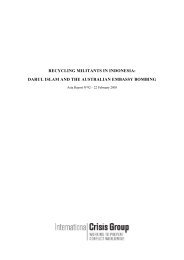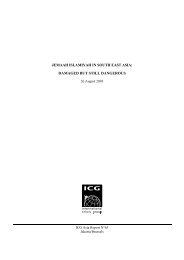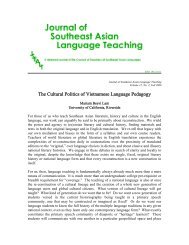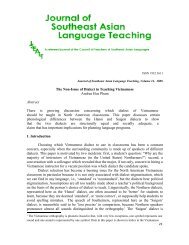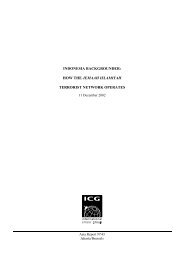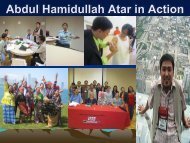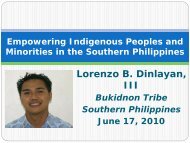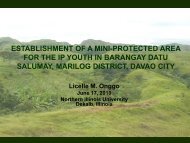Introduction - SEAsite - Northern Illinois University
Introduction - SEAsite - Northern Illinois University
Introduction - SEAsite - Northern Illinois University
You also want an ePaper? Increase the reach of your titles
YUMPU automatically turns print PDFs into web optimized ePapers that Google loves.
Prentation Abstracts<br />
Sianong Phomkong<br />
Foreign direct investment in Lao PDR: Promotion Strategies<br />
Former Deputy Director of Investment Promotion Division, Department for Promotion<br />
and Management of Domestic and Foreign Investment, State Planning<br />
Committee, Lao PDR<br />
Historical Context<br />
Since the Lao People’s Democratic Republic was established on December<br />
2, 1975, the Lao government has been taking various actions aiming to develop<br />
the country. These actions culminated when the government launched the New<br />
Economic Mechanism (NEM) in 1986, moving from a centrally planned economy<br />
to a market-oriented economy. A large number of state-owned enterprises became<br />
privatized.<br />
Implementing the NEM, the Lao government recognizes that foreign direct<br />
investment (FDI) - with its capital, technology, and expertise - can play a crucial<br />
role in the country’s economic development. To attract more FDI, however, the<br />
government tends to emphasize only the liberalization of laws and regulations.<br />
Current Problems<br />
The government decided to open the country for FDI in 1988. It enacted<br />
numerous laws and decrees directly and indirectly governing FDI, yet it has not<br />
been able to ensure the effectiveness of these instruments. Furthermore, the Lao<br />
Government has not marketed the country as a desirable investment destination to<br />
potential foreign investors.<br />
Competition among host countries is severe. Laos’s neighboring countries,<br />
namely Vietnam, Myanmar and China, are also emerging countries. These countries<br />
have advantages over Laos in terms of labor forces, domestic markets, sea<br />
ports, and infrastructure for promoted investments. These countries are campaigning<br />
hard for FDI. Furthermore, Malaysia, Thailand, Indonesia, and other developing<br />
countries in Southeast Asia are also doing their best to keep the investments<br />
they have. Other countries worldwide are also encouraging FDI.<br />
Recommendations<br />
• In order to attract good quality FDI, that will bring the greatest benefit to<br />
the country, the Lao Government must change its promotion strategies. The<br />
government needs to have a clear understanding of<br />
• what FDI is needed<br />
• why the country needs FDI<br />
• profitable sectors<br />
• target investors<br />
• Furthermore, the country should be ready for the investments it aims to attract.<br />
An image should be created for the country to inspire Laotians and<br />
foreign investors.<br />
• Lastly, the Government should launch aggressive FDI promotion campaigns<br />
inside the country and abroad.<br />
Only by following these strategies will Laos succeed in attracting FDI and gain<br />
more benefits from those investments.<br />
Alan Potkin*, Mr. Chaleunxay Phommavongsa,** and Catherine<br />
Raymond**<br />
Linking the Lao Loum Diaspora in <strong>Northern</strong> <strong>Illinois</strong> with Cultural<br />
Conservation Practice in Vientiane<br />
*Team Leader, Digital Conservation Facility, Laos<br />
**Founder, Black and White Studio, Vientiane; Principal consultant, Digital<br />
Conservation Facility Laos<br />
***Associate Professor of Southeast Asian Art History, <strong>Northern</strong> <strong>Illinois</strong><br />
<strong>University</strong><br />
As increasing wealth is generated within the Lao PDR, and also flows there<br />
from outside, the traditional meritorious reconstruction of Buddhist Vats and sacred<br />
sites has been accelerating everywhere around Vientiane. The aggrandizement<br />
of so many temples, to the delight so many people in the bans, has clearly<br />
sometimes come at a cost of disposing of undervalued assets —not all of them<br />
material. The uniquely Lao “cultural capital” recently lost ranges from the superb<br />
Phralak Phralam frescoes demolished with the old Vat Oup Mong vihaan, to an<br />
obscure religious cult necessarily weakened by the proud refurbishing of Vat Chan<br />
on the Old City waterfront: formerly the stark and austere royal seat for propitiating<br />
Lord Sikhottabang’s well-deserved curse.<br />
The conservation of Vat Sisaket —Vientiane’s sole religious monument in<br />
more-or-less its original condition— is a special case in that the local abbot and<br />
the ban cannot rehabilitate the cloistered museum complex on their own initiative:<br />
a mixed blessing, as the surrounding improvements are plentiful. But the will<br />
and the resources to reverse officially Sisaket’s appallingly rapid deterioration are<br />
barely mobilized.<br />
Existing Lao PDR legislation and decrees on archaeological and historical<br />
preservation require formal authorization by the Ministry of Information and Culture<br />
prior to the demolition or the rebuilding of major structures older than fifty<br />
years. In principle, the decisions on what to protect and why, draw upon specialized<br />
knowledge —inside and outside the government— of art and aesthetics; of<br />
history and religion; and of touristic development and practical conservatorship.<br />
How effective are these laws in actuality, how well-used is the available expertise,<br />
and how can the constituencies for cultural preservation be mobilized and<br />
strengthened?<br />
We could now only guess the significance of remittances from overseas Lao<br />
in the redevelopmentof temple compounds in the mother country, especially when<br />
new vats are springing up across the Lao loum diaspora. As Lao immigrants in<br />
North America both resist and embrace assimiliation****, what are their views on<br />
the transformation of the Buddhist cultural landscape back in Vientiane? Are some<br />
Lao becoming more sentimental, more preservationist towards previously-devaluated<br />
relics of “underdevelopment”?<br />
During the weeks before the FICLS, in cooperation with the Lao loum communities<br />
of Burlington, Elgin, and Rockford IL USA we will have installed interpretive<br />
materials and conducted workshops in one or more nearby vats, and will<br />
present our methodology and findings to this Conference.<br />
**** “The process in which one group takes on the cultural and other traits of a<br />
larger group”, (Microsoft Word dictionary).<br />
Elisabeth Preisig<br />
Rice, Women and Rituals<br />
Association for Research and Development, Vientiane, Lao P.D.R.<br />
The paper explores the role of Kmhmu’ women in livelihood, more precisely,<br />
the role in their rice culture. The careful study of the rice culture of the Kmhmu’<br />
reveals an intimate relationship between rice and women. The ritual role of women<br />
in Kmhmu’ rice culture demonstrates the independence and interdependence of<br />
both sexes in the Kmhmu’ family and society, in the face of natural, and supernatural<br />
powers.<br />
Planning and development, or change, without the careful weighing of the<br />
impact on this equilibrium could have a destabilizing effect on their society and<br />
break down patterns of responsibility and authority, thus eroding social structure<br />
and order.<br />
Mountain rice fields cannot be done without reinforcement and help from others,<br />
so people working together well form field clusters and do their fields in close<br />
cooperation, helping each other out throughout the planting cycle. Apart from<br />
physical strength rice as well as rice growers need some supernatural protection<br />
and blessing.<br />
While it is the men who perform most rituals and prayers in the life cycle of<br />
people, and in connection with the ancestors, women share responsibility in field<br />
rituals. In fact, some rituals in the fields even must be performed by a woman.<br />
Following this lead conducts to most interesting results for the understanding of<br />
Kmhmu’ social life and culture.<br />
Boike Rehbein, Ph.D.<br />
Lao Social Structure<br />
Acting Chair of Sociology, <strong>University</strong> of Freiburg, Germany<br />
The tendencies of globalization start to reach the hinterland of the global<br />
periphery, to which the small country of Laos certainly belongs. What do the concomitant<br />
changes mean for the country’s social structure? To answer this question,<br />
the paper draws on the sociology of Pierre Bourdieu. Social structure is conceived<br />
of as a hierarchy of “fields”, the structure of which is determined by the social<br />
agents’ resources or “capital”. Globalization can be understood as a global dif-






